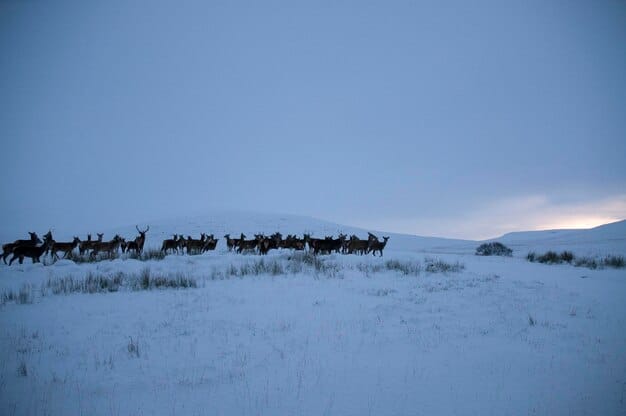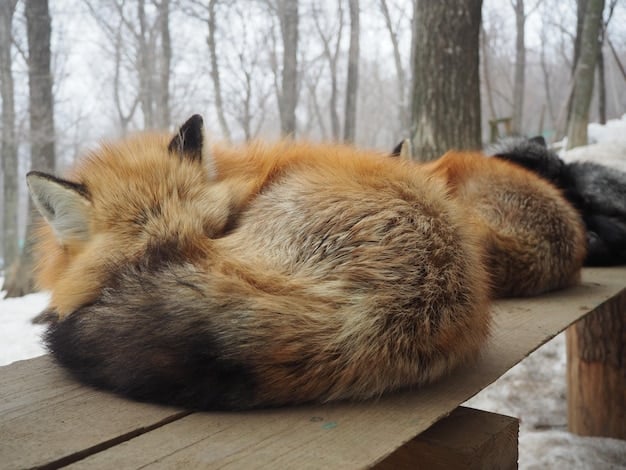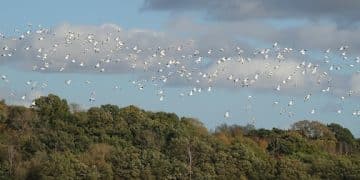How Seasonal Changes Affect Animal Behavior: Survival Adaptations

Seasonal changes significantly influence animal behavior, prompting various adaptations for survival, including migration, hibernation, altered foraging strategies, and physiological adjustments to cope with winter’s challenges.
The changing seasons bring about a multitude of environmental shifts that profoundly impact animal life. Understanding how seasonal changes affect animal behavior: 4 adaptations for winter survival is crucial for appreciating the intricate relationship between animals and their ecosystems.
Understanding Animal Behavior in Changing Seasons
Seasonal changes are a powerful driving force behind animal behavior shifts, from migration to foraging strategies. Animals must adapt to survive the challenges posed by changing temperatures, food availability, and other environmental factors.
These adaptations are not merely instinctive; they are finely tuned responses shaped by evolution to maximize survival and reproductive success in a specific environment.
Why Do Seasons Matter to Animals?
The effects of seasonal shifts are evident in every ecosystem, greatly changing animal behavior and survival tactics. These changes include many things, like food source availibity to extreme temperature change.
- Changes in temperature affect metabolic processes and energy requirements.
- Seasonal shifts in daylight hours influence activity patterns and breeding cycles.
- The availability of food resources fluctuates dramatically throughout the year.
- Animals must cope with increased competition and predation risks during certain seasons.
Understanding how animals respond to these seasonal drivers is key to unlocking the secrets of their behavior and survival.

Migration: A Journey for Survival
Migration is not just a journey; it’s a strategic response to ensure survival. When seasonal changes threaten food and breeding grounds, many animals embark on incredible migrations, travelling hundreds or even thousands of miles to find more amenable conditions.
This adaptation requires precise timing, incredible endurance, and a remarkable sense of navigation.
The Wonders of Bird Migration
Bird migration is one of the most awe-inspiring phenomena in the natural world. Birds migrate in huge numbers in order to find food, warmer climates, and places to breed.
Take the Arctic Tern, for example, which flies the longest migratory journey of any species of bird. These birds flay from the Artic all the way to Antartica to have access to a summer climate for both poles of the world.
Mammalian Migration: Following the Food
Many mammals also undertake migrations, often driven by the search for food. Herds of wildebeest in Africa migrate in huge numbers in order to always have access to fresh grass.
- Caribou in North America migrate long distances between their summer and winter ranges.
- Whales migrate to warmer waters to breed and give birth.
- Bats migrate to find suitable roosting sites and food sources.
Migration is a testament to the adaptability and resilience of animals in the face of environmental change. By moving to more favorable conditions, they can ensure their survival and reproductive success.
Hibernation: The Ultimate Winter Sleep
Hibernation is a highly effective strategy to survive. Many animals can enter a state of inactivity in which their metabolic rate slows down tremendously during the winter when food is in short supply.
This remarkable adaptation conserves energy and allows animals to endure harsh conditions without needing to eat or drink for months.
The Physiology of Hibernation
Hibernation involves profound physiological changes. During hibernation, animals can exhibit a slower heartbeat, body temperature and breathing.
These physiological changes are closely regulated by hormonal signals and neurological circuits. The animal is prepared to lower its body functions to almost nothing.
Examples of Hibernating Creatures
Numerous animals are known to hibernate, each species with unique variations on this survival strategy. Some of the animals include bats, hedgehogs, and groundhogs.
- Bears enter a state of dormancy, similar to hibernation, to survive the winter.
- Ground squirrels significantly reduce their heart rate and body temperature during hibernation.
- Snakes seek refuge in dens and become inactive during the coldest months.
Hibernation is an extraordinary adaptation, allowing animals to conserve energy and survive in environments where resources are scarce during winter months.

Altered Foraging Strategies: Adapting to Food Scarcity
When seasonal changes bring about decreased food availability, animals must modify their foraging techniques in order to have enough food for the winter. This might entail switching to new food sources, keeping food, or working with other people to get food.
These modified strategies are essential for maintaining energy balance and survival.
Caching Food for Lean Times
Caching, or storing food, is a common strategy to surviving food deprivation. Squirrels bury nuts and seeds, while beavers create food piles to eat through winter.
These animals also have an extremely good memory to recall where their food is later down the road.
Changing Diets to Match Availability
When their usual food sources become scarce, some animals adjust their diets to accommodate what is available. Many animals may vary their food depending on what they can get their hands on.
For example, foxes eat berries and fruits in the autumn when prey is scarce. Deer consume tree bark and buds when there is not as much greenery.
Hunting Strategies in Winter
Some predators adapt their hunting strategies to match prey availability in winter. For example, owls improve their ability to hear in order to hunt in the snow.
- Wolves hunt in packs to take down larger prey.
- Lynx rely on snowshoe hares as their primary food source.
By adapting their foraging strategies, animals can ensure they have enough food to survive even when resources are scarce.
Physiological Adjustments: Coping with the Cold
Animals also undertake physiological adjustment that can help them cope with the cold. These adjustments allow animals to bear severe cold weather.
From growing thicker fur to altering blood flow, these adaptations are crucial for survival in cold climates.
Insulation: The Power of Fur and Feathers
Many animals grow thicker fur or feathers in winter to provide insulation against the cold. The Arctic fox develops a dense fur coat that is useful for keeping it warm in frigid temperatures, and the ptarmigan grows additional feathers for better wind and snow protection.
Shivering and Non-Shivering Thermogenesis
Shivering is a physiological response to cold that generates heat through muscle contractions. Additionally, animals produce heat without shivering by using brown fat, a type of tissue that produces heat through metabolic activity.
Regulating Blood Flow to Conserve Heat
Animals will also control blood flow in order to limit the amount of heat they lose. They retain heat by limiting blood flow to extremities like the ears and legs, and they also use countercurrent heat exchange, where arteries and veins in extremities are positioned tightly.
- Arctic birds have countercurrent heat exchange in their legs.
- Marine mammals have thick layers of blubber for insulation.
Physiological adjustments allow animals to cope with lower temperatures, conserving energy and surviving in cold locations. These changes are essential for maintaining body temperature and life.
Behavioral Adaptations for Social Animals
Many social animal species will also adapt their behavior to survive the winter weather. These adjustments can help animals to survive the winter. and even to reproduce.
From huddling for warmth to cooperative hunting, social behaviors play a crucial role in winter survival.
Huddling for Warmth
Huddling is a social behavior where animals gather closely together to share body heat. Penguins huddle in massive flocks to weather Antarctic storms, while small mammals huddle to stay cozy in the face of lower temperatures.
Cooperative Hunting
Cooperative hunting involves multiple animals working together to enhance hunting success. Wolves hunt in packs to catch enormous prey, while lions collaborate to bring down larger animals.
- Meerkats take turns acting as sentinels to alert the group of danger.
- Honeybees cooperate to regulate the temperature of the hive.
Social creatures improve their chances of surviving in difficult winter conditions by huddling for warmth, cooperating on hunts, and sharing resources. Social behavior is essential for survival in difficult environments.
| Key Concept | Brief Description |
|---|---|
| 🌍 Migration | Animals move to find better climates or more food. |
| 😴 Hibernation | Animals slow down their body processes to save energy. |
| 🍎 Foraging | Animals change what and how they eat to survive. |
| 🌡️ Physiological | Animals change their body functions to handle the cold. |
Frequently Asked Questions
▼
Animals migrate to find food, escape harsh weather, and breed. Seasonal changes affect resource availability, triggering movement to more favorable locations to enhance chances of survival.
▼
Hibernation lowers an animal’s metabolic rate, reducing energy consumption. This allows animals to survive periods of food scarcity and cold temperatures, conserving energy stores until conditions improve.
▼
Animals adapt by caching food, changing diets to what’s available, and adjusting hunting strategies. These tactics ensure they get enough sustenance to survive when resources are scarce.
▼
Animals grow thicker fur, shiver to generate heat, and regulate blood flow for heat conservation. These adjustments help them maintain body temperature and survive in freezing environments.
▼
Social behaviors such as huddling and cooperative hunting improve winter survival odds. Sharing body heat and collaborating to find food enable animals to endure harsh winter conditions effectively.
Conclusion
In conclusion, the intricate ways how seasonal changes affect animal behavior: 4 adaptations for winter survival, highlight the adaptability and resilience of animals. From migration to hibernation, varied food-gathering strategies, physical changes and behavioral adaptations, animals use any means to survive the yearly journey. Understanding these tactics allows us to comprehend the complex interrelationships that exist in our natural ecosystems.





